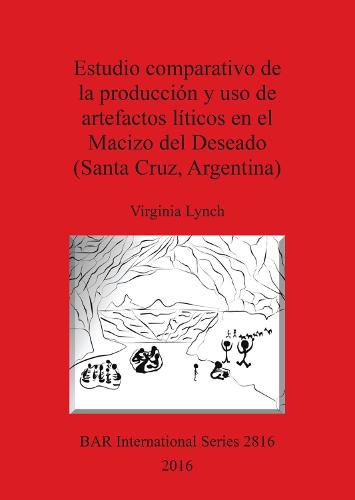Readings Newsletter
Become a Readings Member to make your shopping experience even easier.
Sign in or sign up for free!
You’re not far away from qualifying for FREE standard shipping within Australia
You’ve qualified for FREE standard shipping within Australia
The cart is loading…






This title is printed to order. This book may have been self-published. If so, we cannot guarantee the quality of the content. In the main most books will have gone through the editing process however some may not. We therefore suggest that you be aware of this before ordering this book. If in doubt check either the author or publisher’s details as we are unable to accept any returns unless they are faulty. Please contact us if you have any questions.
El siguiente estudio se focaliza en las modalidades de uso de las tecnologias liticas manufacturadas por diferentes grupos cazadores-recolectores, que habitaron la Meseta Central de Santa Cruz (Argentina), desde la transicion Pleistoceno-Holoceno al Holoceno Tardio (ca. 13.000 anos C14 AP hasta tiempos historicos). Este trabajo se desarrollo a partir del analisis tecno-morfologico y funcional de base microscopica, de los conjuntos artefactuales procedentes de los sitios Cueva Maripe y Alero El Puesto 1 (AEP1), de la localidad arqueologica Piedra Museo. La metodologia aplicada, mediante diferentes medios opticos y en base a una intensa labor experimental, ha permitido determinar la recurrencia y variabilidad en usos y disenos en diferentes bloques temporales de ocupacion. Esto permitio constatar aspectos economicos y simbolicos de las practicas tecnologicas; al igual que, formular supuestos acerca de la importancia del contexto de uso del instrumental litico en la organizacion social de grupos que habitaron desde epocas tempranas este sector de la Patagonia Argentina. This work includes the study of use traces of lithic technologies manufactured by different hunter-gatherer societies from the Central Plateau of Santa Cruz (Argentina). The time period studied is from the Pleistocene-Holocene transition to the Late Holocene (ca. 13,000 years AP C14 to historical times). Techno-morphological studies, microwear analysis and experimental archaeology were applied to lithic materials of the Cueva Maripe and Piedra Museo sites. Similarities in the design and use of lithics during the different periods of occupation of the study sites were identified. This allowed us to determine the economic and symbolic aspects of the technological practices, and to formulate assumptions about the importance of the context of use of lithic technologies in the social organization of the groups that inhabited at the Central Plateau of Santa Cruz (Patagonia, Argentina).
$9.00 standard shipping within Australia
FREE standard shipping within Australia for orders over $100.00
Express & International shipping calculated at checkout
This title is printed to order. This book may have been self-published. If so, we cannot guarantee the quality of the content. In the main most books will have gone through the editing process however some may not. We therefore suggest that you be aware of this before ordering this book. If in doubt check either the author or publisher’s details as we are unable to accept any returns unless they are faulty. Please contact us if you have any questions.
El siguiente estudio se focaliza en las modalidades de uso de las tecnologias liticas manufacturadas por diferentes grupos cazadores-recolectores, que habitaron la Meseta Central de Santa Cruz (Argentina), desde la transicion Pleistoceno-Holoceno al Holoceno Tardio (ca. 13.000 anos C14 AP hasta tiempos historicos). Este trabajo se desarrollo a partir del analisis tecno-morfologico y funcional de base microscopica, de los conjuntos artefactuales procedentes de los sitios Cueva Maripe y Alero El Puesto 1 (AEP1), de la localidad arqueologica Piedra Museo. La metodologia aplicada, mediante diferentes medios opticos y en base a una intensa labor experimental, ha permitido determinar la recurrencia y variabilidad en usos y disenos en diferentes bloques temporales de ocupacion. Esto permitio constatar aspectos economicos y simbolicos de las practicas tecnologicas; al igual que, formular supuestos acerca de la importancia del contexto de uso del instrumental litico en la organizacion social de grupos que habitaron desde epocas tempranas este sector de la Patagonia Argentina. This work includes the study of use traces of lithic technologies manufactured by different hunter-gatherer societies from the Central Plateau of Santa Cruz (Argentina). The time period studied is from the Pleistocene-Holocene transition to the Late Holocene (ca. 13,000 years AP C14 to historical times). Techno-morphological studies, microwear analysis and experimental archaeology were applied to lithic materials of the Cueva Maripe and Piedra Museo sites. Similarities in the design and use of lithics during the different periods of occupation of the study sites were identified. This allowed us to determine the economic and symbolic aspects of the technological practices, and to formulate assumptions about the importance of the context of use of lithic technologies in the social organization of the groups that inhabited at the Central Plateau of Santa Cruz (Patagonia, Argentina).